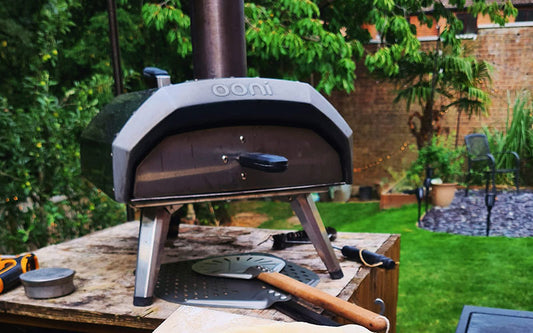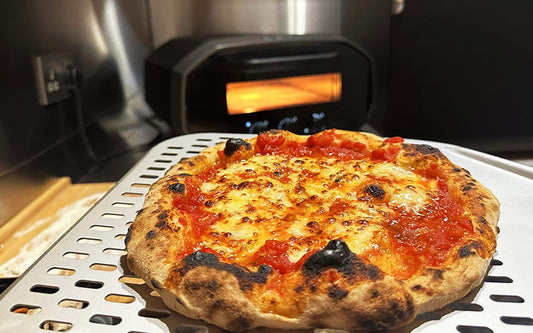The hardest, as well as the most satisfying bit of making a pizza, is getting the dough right. How long you let the dough rise will determine the flavor and structure of the pie.
There are many factors that can affect how long to let the pizza dough rise. This includes temperature, humidity, yeast type, and age, as well as gluten development.
The general rule is to let pizza dough rise until it has doubled in size, which could take anywhere between 1-1.5 hours. This will give the yeast time to activate and create a light, airy texture in the crust.
However, I personally prefer cold-fermenting the dough for 48 hours for extra flavor.
In this article, I will thoroughly discuss factors that affect the rising time of pizza dough. That’s not all.
I will also address the core problems people face while proofing the dough and share a few troubleshooting tips along the way too.
So if your dough isn’t quite turning out right due to under-rising, over-rising, or uncertainty on ideal times, keep reading to find the solution.
Estimated Rising Times for Different Pizza Doughs
Pizza dough rising times are primarily influenced by three factors: yeast, hydration, and temperature (including both room temp proofing and cold proofing). Take a look at this chart below to get a basic idea:

Pizza Dough Rising Window: Based on Yeast
| Yeast Type | Rising time in room temp, (70-75°F/21-24°C) | Rising time in the fridge (38-40°F/3-4°C) |
| Active yeast | 1-2 hours | 18-24 hours, up to 3 days |
| Instant yeast | 45-60 minutes | 12-18 hours, up to 2 days |
| Fresh yeast | 2-3 hours | 24-36 hours, up to 5 days |
| Sourdough starter | 4-6 hours | 24-48 hours, up to 5 days |
I have spent countless hours testing different types of yeast to see how they affect the rise time of my dough. Here’s a summary of my findings based on a recent experiment:
I once made four batches of pizza dough, one using sourdough starter, one using fresh yeast, one using active dry yeast, and one using instant yeast.
I mixed the doughs all at the same time and placed them in a warm place to rise. After one hour, the instant yeast dough had doubled in size.
The active dry yeast dough had risen about 75%, the fresh yeast dough had risen about 50%, and the sourdough starter dough had barely risen at all.
I let all four doughs continue to rise until they had doubled in size. This took about 2 hours for the active dry yeast dough, 3 hours for the fresh yeast dough, and 6 hours for the sourdough starter dough.
I then baked all four pizzas and found that the sourdough starter dough pizza had the best flavor and complexity.
The fresh yeast dough pizza was also good, but the active dry yeast dough pizza and the instant yeast dough pizza were slightly less flavorful.
The Takeaway
- I found that sourdough starter produced the most flavorful and complex dough, but it also had the longest rise time.
- Fresh yeast was a good middle ground, and active dry yeast and instant yeast were the fastest-rising yeasts, but they produced slightly less flavorful doughs.
Pizza Dough Rising Window: Based on Dough Hydration
The flour’s ability to absorb water is another crucial factor determining the ideal rising time of your dough. Take a quick glance at the table below:
| Hydration | Rising time in room temp, (70-75°F/21-24°C) | Rising time in the fridge (38-40°F/3-4°C) |
| Low hydration (60-65%) | 2-3 hours | 12-18 hours, up to 24 hours |
| Medium hydration (65-70%) | 1.5-2 hours | 18-24 hours, up to 3 days |
| High hydration (70%+) | 1-1.5 hours | 24-36 hours, up to 5 days |
The whole point of hydrating the dough is to produce carbon dioxide gas, which causes the dough to rise. While kneading, the carbon dioxide gas bubbles get trapped in the gluten network of the dough, allowing the dough to rise.
With lower hydration, the yeast has to work harder to produce carbon dioxide gas. This results in a longer rise time. However, lower-hydration doughs are also easier to handle but produce a denser, chewier crust.

Medium hydration doughs exhibit a good balance of water and flour, which results in a moderate rise time. Medium hydration doughs are also relatively easy to handle and produce a crust with a good balance of chewiness and airiness.
High hydration allows the yeast to easily produce carbon dioxide gas, leading to a faster rise time. That said, high-hydration doughs are also very sticky and difficult to handle. But the resulting crust is soft and pillowy with large air bubbles.
Pizza Dough Rising Window: Based on Ambient Temperature
The temperature in your kitchen is the final factor that will determine how long exactly your dough takes to rise. Don’t forget to factor in the humidity as well because muggier weather will mess with the hydration of your dough. Lovely, innit?
| Ambient Temperature | Rising time in room temp | Rising time in the fridge |
| 75-80°F/24-27°C | 1-1.5 hours | 12-18 hours |
| 65-70°F/18-21°C | 1.5-2 hours | 18-24 hours |
| 60-65°F/16-18°C | 2-3 hours | 24-36 hours |
| 40-42°F/4-6°C | 18-24 hours | 48-72 hours |
| 38-40°F/3-4°C | 24-36 hours | 72-96 hours |
| 34-36°F/1-2°C | 36-48 hours | 96-120 hours |
Pro tip: Here’s a rule of thumb I follow to control the rising time when the humidity level goes above or below the idea level:
I adjust the amount of water by adding a splash of oil to the dough. The oil acts much like water because it makes the dough softer and easier to deal with when humidity is present.
The trick is to know when to add the oil to the dough mix so that you don’t run into crust inconsistencies and ruin your batch of dough.
I’d advise you to add the oil after your flour is hydrated so that the gluten forms properly.
I have also found that the best temperature for rising pizza dough for me is between 65-70°F/18-21°C. This temperature allows the yeast to be active without causing the dough to over-rise. I live in a cold and dry area.
So, I use a humidifier to keep the humidity between 65-70%. This helps to prevent the dough from drying out or becoming too sticky.
Fridge Slow-Rise: Boosting Flavor Overnight
I know it sounds crazy, but you can actually chill the dough for up to 5 days. This will slow down the fermentation process and give you more control over the texture of your crust.

Cold fermenting for 3-5 days can dramatically improve the flavor of your dough, and it’s a great way to get the perfect balance between chewy and airy. When you are ready to use chilled dough, take it out of the fridge and let it sit at room temperature for 1-2 hours before rolling it out or shaping it into balls.
That said, I understand that not everyone has that kind of patience or time. A one-day quick ferment in the fridge will still result in a delicious, albeit relatively denser crust. It won’t get you that leopard-spotting Neapolitan pizzas are known for because it won’t have as many air bubbles as a longer-proofed dough.
Stick to overnight chilling, and you will end up with a uniformly browned, delectable homemade pizza, I promise.
Below, I have chalked out a comparison table to demonstrate how different fridge rising times influence the quality of the dough as well as the finished product:
| Cold fermentation period | Ease of handling | Texture | Taste |
| 6-12 hours | Slightly sticky | Chewy and slightly airy | Enjoyable and lacks depth of flavor |
| 12-24 hours | Easier to handle | Chewy and airy | More complex and flavorful |
| 24-36 hours | Very easy to handle | Very airy and light | Very complex and flavorful |
| 36-48 hours | Difficult to handle | Very airy and light | Very complex and flavorful, but may have a faint sour taste |
| 48-72 hours | Extremely difficult to handle | Extremely airy and puffy with a slightly chewy crust | Extremely complex, and flavorful, with a slightly sour taste |
| 72-96 hours | Handling such jiggly doughs requires extensive training and serious expertise | Leopard spotted crust with large air pockets. | Amazing flavor profile with a pleasant hint of sourness. |
Best Place To Let Pizza Dough Rise
The best place to let pizza dough rise is in a warm, draft-free spot. You can use an electric blanket set on low heat and put your pizza dough in a wooden bowl covered with a towel.
The goal is to create a warm and humid environment that gets the yeast moving. The more freely the yeast moves inside the dough, the better rise you get.

In cold weather, it’s best to let the dough rise in the oven. Preheat the oven to 100°F for about a minute or two, then turn it off. Place your pizza dough in a greased, heat-proof bowl, cover it with a damp towel, and place it in the oven. Let it sit there for 45-60 minutes before use.
Alternatively, you can also boil a cup of water in the microwave. Once the water is boiled, move the cup of water aside and put the bowl of dough in the microwave.
Shut the door and turn off the microwave. The dough should double in size in 30-45 minutes. This is by far the best way to make your pizza dough rise faster.
How To Know Pizza Dough Is Ready?
If it springs back too fast, let it rise for about 15 more minutes and check again. You can also use a thermometer to test how warm your pizza dough is; if it registers above 65 degrees, then you are good to go. Anything colder than that will be too difficult to stretch.

A little poke test is the most foolproof way to ascertain whether the dough is ready for the bake. Use your finger or a wooden spoon to poke the dough. If it springs back slowly, leaving a small indentation, it’s ready for the oven.
While the above two are the most common ways to test the readiness of the pizza dough, there are a few visual cues to determine the same:
- Size: The dough should have doubled in size.
- Jiggle: When you gently shake the dough, it should jiggle slightly.
- Bubbles: The dough should be full of small bubbles.
- Smoothness: It should be smooth and elastic to the touch.
Why Your Dough Isn’t Rising – 5 Common Issues
Despite your best efforts, there are several reasons why your pizza dough might not be rising. In my experience, there are usually five reasons for this:
1. The yeast is dead
If your yeast is more than a few months old, it might not be viable anymore. Try using fresh yeast or proofing the yeast before adding it to your dough.
Troubleshooting Tip:
You can test whether your yeast is active by mixing up some water and sugar (making sure it’s 100% dissolved), then adding in a small amount of the yeast mixture (1/4 teaspoon). If bubbles form within 15 minutes, you know that the yeast is still good.
2. Incorrect water temperature
Your water temperature is too hot or cold, and it kills the yeast while proofing. This can happen if you add warm water straight from the tap (which is typically around 100 degrees F).
Troubleshooting Tip:
The best way to test this is by using an instant-read thermometer.
This will tell you whether the water temperature is between 100 and 110 degrees F. If it’s too hot, let it sit until it cools down a bit. If it’s too cold, warm it up in the microwave for about 30 seconds before adding the yeast.
3. Too much flour
The most common reason for flat, under-proofed pizza dough is adding too much flour to your recipe. Adding too much flour to a pizza dough recipe can cause the yeast to die off before it has had a chance to ferment properly and form those air bubbles.
Always add flour gradually to the dough until it just comes together. If the dough is too sticky, then only add more flour but only a tablespoon at a time.
Troubleshooting Tip:
To fix this issue, I’d suggest adding more water 1-2 tablespoons at a time, and knead the dough until it is smooth. Let the dough rest for 30 minutes, then proof it in a warm place (70-75°F/21-24°C).
If the dough still doesn’t rise after following these steps, I’m afraid you’ll have to start over. Since I always go for the “rather be safe than sorry” approach, I like to measure everything with a kitchen scale before mixing.
4. Too much yeast
Adding too much yeast to a pizza dough recipe will cause the dough to rise too quickly and then collapse when it comes time to bake. This is why many recipes call for “proofing” their yeast before adding it to the batter.
By letting your active dry yeast sit in warm water for 10 minutes or so, you can test the strength of your mixture by seeing if bubbles form on top of the water.
Troubleshooting Tip:
If you have ended up adding more yeast than the recipe needs, here’s what I recommend doing:
Rest the dough in the fridge for a longer period. The colder temp will slow down the yeast activity. You can also try adding more flour to dilute the amount of yeast in the dough. However, be careful not to add too much flour, or the dough will become dry and tough.
Skip this step if this is your first time making fresh pizza dough. If you don’t know what you are doing, the dough WILL dry out.
5. Overproofing
Can pizza dough rise too much? Hell yeah! Been there, done that.
Overproofing the pizza dough keeps it from rising in the oven while baking because the yeast has consumed all of the sugar in the pizza dough.
Troubleshooting Tip:
The only way to rescue an over-proofed pizza dough is to knock back the dough.
To do that, take the dough out of the proofing box/container and press it down with the heel of your hands. Lightly punch the dough to release all the air out, reshape it into balls, and put it back in the container.
Let the dough rest for a few minutes before baking.
Punching down the dough will help release carbon dioxide gas that has been produced by the yeast. This can slow down the rise of the dough and help prevent over-fermentation.
Speeding Up a Slow Rise: Key Takeaways
- Make Sure Your Yeast Is Alive and Kicking: If your yeast is dead, it won’t be able to produce enough gas for the dough to rise. To test if your yeast is alive, dissolve a small amount of it in warm water and sugar. If the yeast bubbles after 5-10 minutes, it is alive and can be used. Check the expiry date of the yeast before use, ALWAYS!
- Test the Water Temperature: Yeast is most active in warm water (105-115°F/41-46°C). Anything hotter than that will kill the yeast. If the water is too cold, the yeast will become dormant. Use a thermometer to ensure that the water is at the correct temperature for the yeast.
- Do not over-flour: Too much flour will mess with the yeast activity and also cause the dough to dry out. Measure your flour, and add it to the dough gradually. If the deed is already done, you can try adding 1-2 tsp of water, knead well, and let the dough rest at room temp for 30 additional minutes.
- Excessive Yeast: Adding too much yeast in the dough will make it sticky, difficult to handle, and cause a sour taste. The best way to handle this problem is to cold ferment the dough for a longer period.
- Overproofing: If you have ended up over-proofing your dough with the addition of extra yeast or longer than necessary proofing, gently punch it down to de-gass the dough. Then re-shape it and proof at room temp for 15-20 minutes.
Related FAQ
How Long Can You Let Pizza Dough Rise With Instant Yeast?
Because instant yeast works differently than active dry yeast, it doesn’t take as long to rise. You’ll want to let it sit for about an hour before you begin making your pizza dough. This is because instant yeast doesn’t need any time to activate; it will be ready to use right away after mixing with water and sugar.
What Happens If You Don’t Let Pizza Dough Rise?
If you don’t let pizza dough rise, then it will not be able to trap the air bubbles that make for a light and airy crust. This will result in flat and dense bread that won’t have much flavor or texture.
How Long to Let Pizza Dough Rise at Room Temperature?
It really depends on the room’s temperature. A warmer environment leads to a faster rise. At 70-75 degrees, the dough can take anywhere between 1-3 hours. You can leave the dough to sit at room temperature for up to 6-10 hours to proof it as well. If you wish to let it rise for longer, put it in the fridge.
Can You Let Pizza Dough Rise Twice?
Yes. In fact, letting the dough rise twice is highly encouraged if you’re making Neapolitan-style pizza. This is because it gives a lot more time for the yeast and dough to interact with one another and create that perfect, chewy crust.
My Takeaway
All in all, it’s important to know how long to let pizza dough rise. You don’t want your dough to be too dry or too wet—you want it just right. And this takes some experimentation on your part. But once you’ve found the perfect combination of ingredients and have the right amount of time for rising, your pizza will come out perfect!




